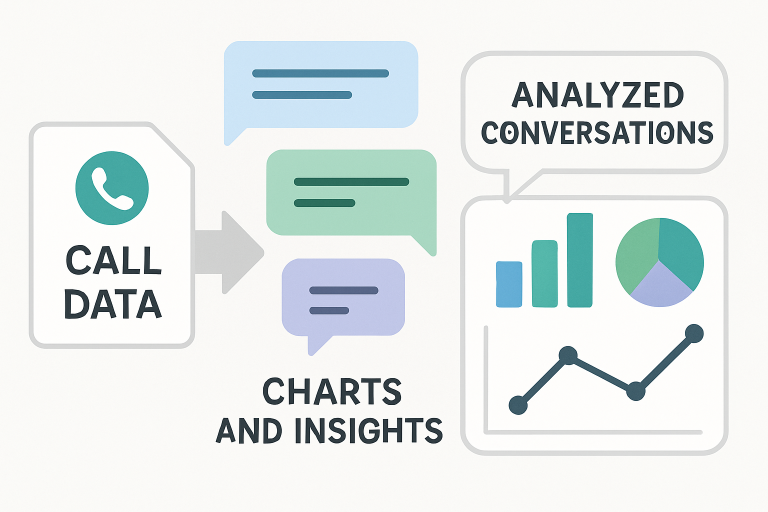Key Takeaways
- Conversational analytics software transforms call data into actionable business intelligence, driving enhanced customer experiences and operational efficiency.
- Integrating conversation analytics with call tracking can lead to enhanced customer insights, better agent performance, and more strategic decision-making.
- Implementation requires clear objectives, the right technology, and ongoing monitoring to ensure success.
- Businesses must remain mindful of privacy, accuracy, and resource management when deploying these solutions.
- Staying informed on trends such as AI and predictive analytics is crucial for maintaining a competitive edge.
Introduction to Conversational Analytics
Enterprises today are awash in data, but a significant portion of business insights hides within conversations—phone calls, chats, and emails with customers. This is where conversational analytics software steps in. By transforming unstructured audio and text data into actionable insights, companies can unlock patterns and opportunities that were previously obscured. Whether it’s surfacing recurring pain points or identifying high-value leads, these insights power smarter business decisions.
For organizations invested in call tracking, conversational analytics software helps bridge the crucial gap between voice interactions and measurable outcomes. With comprehensive analytics, you can dig into every customer interaction for detailed trends, customer sentiment, and workflow improvements—making every call count toward strategic growth.
Key Features of Conversational Analytics Software
- Real-Time Transcription: Instantly converts spoken conversations into searchable, analyzable text, giving teams immediate access to customer insights.
- Sentiment Analysis: Evaluates the tone, intent, and attitudes of speakers, helping pinpoint satisfaction and frustration triggers.
- Keyword Spotting: Scans conversations for specific terms or topics—ideal for tracking campaign effectiveness and compliance needs.
- Trend Identification: Aggregates insights over thousands of calls, highlighting emerging issues, seasonal patterns, and unanticipated opportunities.

Benefits of Integrating Conversational Analytics into Call Tracking
Layering conversational analytics onto your call tracking infrastructure yields several high-impact advantages for your business:
- Enhanced Customer Insights: Go beyond basic call logs and understand the root cause behind customer behaviors, needs, and objections. This allows for targeted customer engagement and clearer segmentation. As highlighted in UCToday, conversation intelligence analytics plays a crucial role in uncovering these insights.
- Improved Agent Performance: Help customer service and sales agents upskill through direct, data-driven feedback from real interactions instead of guesswork or sporadic monitoring.
- Operational Efficiency: Quickly identify common bottlenecks across thousands of calls, enabling you to streamline processes, automate repetitive tasks, and redeploy resources for maximum impact.
- Data-Driven Decision Making: Rely on comprehensive analysis rather than assumptions, ensuring strategy pivots are based on customer realities.
These benefits extend beyond immediate business impact.
Implementing Conversational Analytics: A Step-by-Step Guide
- Define Objectives: Start by clarifying your primary business challenges. Are you hoping to reduce call handling time, identify new sales opportunities, or improve compliance?
- Select the Right Platform: Evaluate solutions for industry fit, feature depth, scalability, and integrations. Ensure the platform can align with your goals and existing call tracking setup.
- Integrate Seamlessly: Work with your IT and operations teams to connect the software with your phone systems, CRMs, and data warehouses.
- Train Your Team: Equip staff across business units with training and ongoing support, ensuring everyone can access and utilize data insights effectively.
- Monitor and Adjust: Regularly review analytics dashboards and reports, tweak configurations, and gather user feedback to improve usability and ROI.
Pro Tip:
Engage stakeholders from day one. Open communication lines between IT, compliance, front-line agents, and leadership to create shared ownership of KPIs and ongoing outcomes.
Challenges and Considerations
- Data Privacy: Scrupulously adhere to regulatory standards like GDPR, CCPA, and industry-specific mandates. Customer trust hinges on responsible data handling.
- Transcription Accuracy: Address challenges in speech-to-text, such as heavy accents, audio quality, or technical jargon, by choosing advanced AI-driven solutions.
- Resource Allocation: Budget for setup, training, and ongoing optimization. Maximizing impact requires dedicated champions and continuous oversight.
Addressing these issues head-on ensures that your transition to advanced analytics doesn’t create new headaches for your team or your customers.
Future Trends in Conversational Analytics
- AI and Machine Learning: Smarter algorithms will enable more nuanced, personalized insights from every customer interaction, forever raising the bar for customer expectations.
- Multichannel Analytics: Analysis is expanding beyond phone calls to integrate live chat, social media, and email—delivering a unified view of customer experiences across platforms.
- Predictive Analytics: Leveraging historical data to anticipate needs, predict churn, and personalize engagement before customers even reach out.
Companies that prepare today for these advancements are likely to maintain a decisive competitive advantage in the near future.
Conclusion
The data revolution continues, and conversational analytics software is at its cutting edge. By unlocking the full potential of conversations—transforming them into measurable, strategic insights—businesses can deliver superior customer experiences, drive operational efficiencies, and remain agile in a rapidly changing market. Informed investment in these tools will enable organizations to evolve alongside their customers, setting new standards for excellence in every interaction.


[…] link: Learn about communication analytics for business […]